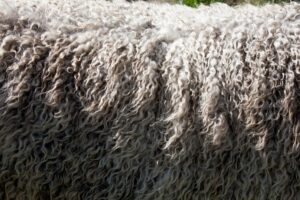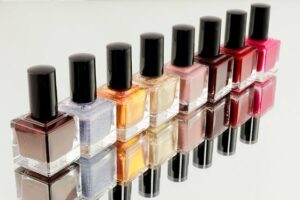Do you know which animal-derived ingredients are often found in make-up? The extent to which other sentient creatures on this planet are used by just one species, humans, is astounding! That’s before we even get on to testing the various ingredients and the finished products on yet more animals!
Ugh! So, how to check?
Unfortunately, many ingredients may be either animal or plant-derived, but the common name of the ingredient is the same, so you must do further due diligence.
If you’ve ever wondered what, if any, animal ingredients are in your makeup or why so many make-up items contain animal parts and derivatives, read our list of 28 of the most common to find out. It’s a long list, so, in no particular order, here are the first 14 and next week we’ll post the other 14.
1) Lanolin
You will see this ingredient everywhere as it is one of the most common. It comes from sheep wool and as a natural emollient, (a fatty ingredient used for moisturising, softening, smoothing), you will typically find it in all manner of products for the body, (think glosses, lipsticks and lip salves), body balms and butters, It’s also found in shampoos and conditioners for the hair and things such as soaps, where it is used to replace natural oils lost during washing. Both synthetic and plant-derived versions of lanolin exist, but even though you may see some versions labelled as ‘cruelty-free’, this could still have come from wool. (Check out our post here explaining the difference between ‘cruelty-free’ and vegan). Great alternatives to lanolin include shea butter, coconut butter oil and coconut oil, and olive oils.
2) Glycerine
This is another ingredient that is used in a whole variety of products, from foodstuffs to body care and other uses. It is a fat which is commonly animal-derived, but vegetable glycerine is also quite common. In cosmetics and body products, you will find glycerine in soaps, shampoos, conditioners, make-up items such as mascara and products for the lips, and facial and body moisturisers. If you want your soaps with vegetable glycerine only, there is a huge range to choose from.
3) Hyaluronic acid / Hylauronan
This ingredient has really gained popularity in recent years, due to its ability to retain moisture, which helps to plump out skin, reducing the appearance of fine lines and deeper wrinkles. In fact, it’s contained naturally within our bodies, but its production declines with age. Hyaluronic acid is usually obtained from rooster combs at the time of slaughter. However, many vegan versions exist (these are extracted from plants and created in the lab) and are easily available.
4) Cera Alba / Beeswax
A more obvious one if you see it listed as ‘Beeswax’. This is a natural wax produced by bees which is used as a key part of hive construction. As it naturally contains a lot of fatty acids, in cosmetics such as lip products its function is to help provide structure to the products to keep them solid without being hard, and it can provide water-proof properties.
5) Bee propolis.
This is a mixture of wax and the sap from trees, produced by bees to seal the hive once built and the honey they deposit in their honeycombs. Another natural emulsifier, it also contains moisturising, anti-fungal and antibacterial properties. You will find it in emulsions for the face, deodorants, toothpaste, after-shave lotions, shampoos and conditioners, and creams used to treat some common skin disorders.
6) Tallow / Oleic acid / oleyl oleate/ oleyl stearate
An extremely common emollient, this is pure animal fat, and used to be the only real way to make soap and candles. Like the other emollients on our list, this ingredient has softening and conditioning properties, which is why (as well as being cheap as millions of animals are slaughtered daily), it is used in soaps, moisturisers, cosmetics and even in nail polishes.
When labelled as tallow, you can be sure it is animal fat. When given any of it’s other names, it just might be vegetable-derived, – in those cases coming from nut sources, coconut or olives.
7) Shellac
While we are on the subject of nail varnishes, Shellac can be found there and in haircare products (as well as being a key ingredient in confectioners glaze on food and resins on instruments such as guitars and violins, and in sealing waxes). Shellac is secreted by the female lac bug which lives on trees Southeast Asia. The waxy substance is scraped from the tree bark along with many thousands of the bugs and then heated to form a liquid.
8) Stearic Acid
Also known as Octadecanoic acid, this is a natural fatty acid found in both animal and vegetable fats. When from animal sources, it is generally taken from the stomachs of slaughtered cows, pigs and sheep. In cosmetic applications, it’s used as an emulsifier in soaps, moisturisers, hair products, facial cleansers and deodorants, where its function is generally to keep substances together whilst allowing them to spread easily. There are non-animal forms of stearic acid, but like most of the ingredients on this list, they share their name with the animal version.
9) Carmine/Cochineal / Natural Red No. 4
This very common (and ‘natural’) ‘dye’ is quite literally made of squished bugs! Going back to the times of the Inca and the Maya, the (X) bugs, which are already naturally red, are squashed and … that’s it! As the insects are so tiny, literally thousands of them are mashed up to produce just a small drop of dye. The ‘dye’, or liquidised bugs are still mostly harvested from Mexico and Peru these days and can be found in everything from foodstuffs to cosmetics, to clothing dyes to paints. Basically, if it’s red, it’s worth checking if it has crushed bugs in it. In cosmetics, you will find it in lipsticks, eye shadows, blushes and nail polishes.
10) Collagen
Collagen is everywhere these days, from people espousing the properties of drinking or consuming it, to skincare companies including it in their cremes and serums, especially those that claim to counteract the signs of aging. You will sometimes see ‘hydrolysed collagen’ on the ingredients list. But what is collagen? It’s a protein found in the skin, connective tissue and bones of animals, including humans. (Gelatine is essentially cooked collagen). As our own production of collagen declines as we age, the theory is that we can replace it by consuming the same amino acids and nutrients it’s comprised of.
11) Royal Jelly
Royal Jelly is the foodstuff used by bees to feed larvae in the hive and specifically, the Queen bee – hence the name ‘Royal Jelly’. Other adult bees must feed on honey. As it contains trace minerals and B vitamins, along with antioxidants, it is thought that topical applications may help to reverse the signs of aging, as well as helping combat certain skin conditions.
The method of extraction of royal jelly is to manipulate hives so that more queens are produced, which are then subsequently killed. BeeCosmetics.co.uk, whose products are based on ingredients produced by bees, say they refuse to use royal jelly in their products.
12) Elastin
Hydrolysed elastin, harvested from fish (marine collagen), dead cows and birds is a
Humectant within the beauty industry. Elastin in our skin is what gives it a springy texture. Just as with collagen, elastin production declines with age and many environmental factors destroy the amounts we have naturally. Despite cosmetics manufacturers shouting loud and proud about the ‘benefits’ of elastin in their products, the elastin molecules cannot possibly be absorbed by the skin because they are far too large!
13) Guanine / CI 75170
Whilst we’re on the subject of fish scales, this is where guanine is harvested from. Find it in bath products, cleansers and other skin care, hair care products and makeup such as lipsticks. Within these products, guanine, (one of the building blocks of DNA), gives them a pearly, iridescent shine. Fish scales – the shine makes sense, doesn’t it? While many versions of guanine these days are synthetic, fish scales are still used, and it’s likely to appear in the ingredients as CI 75170 and ‘natural pearl essence’.
14) Keratin
This is the protein that your hair and nails are made from. Included in haircare and nail care products, it apparently helps to smooth down the hair shaft, and the theory goes, be absorbed by the scalp to help to promote lustrous, shiny locks or the nails for stronger nails. It’s commonly derived from sheep wool, but also from hooves, horns and feathers from the slaughterhouse. Some vegan keratin treatments do exist however, usually extracted from wheat, soy and lentils.




